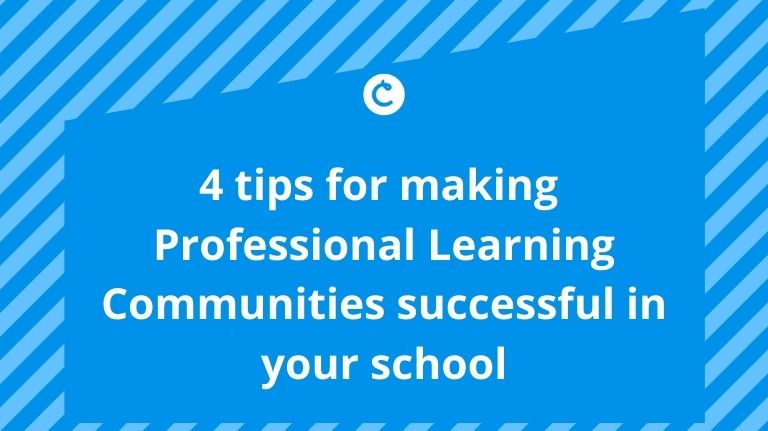4 tips for making Professional Learning Communities successful in your school

More schools are adopting the Professional Learning Communities (PLC; learn more) process as the way to work together and reach students more effectively. PLC works. It isn’t a program or something your district purchases. It isn’t a meeting, but it does require meetings. Effective Professional Learning Communities require everyone to work collaboratively and take control of their specific role in the PLC, from both the district and school level. Everyone. It’s not a quick fix, but rather is a never-ending process that works to improve teachers in the organization, and will produce better results for students. So how do we get other teachers and staff on-board for utilizing Professional Learning Communities?

Dave Burgess, author, publisher, and keynote speaker, says you must create a snowball effect and get it rolling downhill.
The hardest part is overcoming inertia and getting it rolling in the first place, so that’s why it’s best to start it rolling while it’s still small. It doesn’t matter that it started small because it will gather and pick up snow as it makes its way down the hill.
And he’s exactly right. To make Professional Learning Communities effective in your school, start with the few who are willing to make your PLC work. That’s your snowball. Here are also a few tips for getting your PLC running and your colleagues on board.
1. Make it fun – To help your PLC realize that this isn’t a one-and-done process, have fun with your collective commitments. Create an online form combined with a voting box accessible to all students (grades 3-12) or staff photos in cafeteria and vote with stickers (grades K-2), and have them vote on the staff member (not just teacher) who exemplifies one of your commitments. For best results, vote once a month at a designated time. Start this at the beginning of the school year after making everyone, students and staff, aware of the collective commitments. The winner gets a crazy inexpensive prize, a picture with their immediate administrator, and maybe a shoutout on the school’s social media. The idea isn’t to spend money here, but to get yourselves, your staff, and your students thinking about those commitments. Once they start thinking about them, then they’ll ponder how to live them. Students will start looking for and expecting them. Now your snowball is growing.
2. Encourage feedback – Building in time for teachers to share what is working for them with the rest of the staff, or incorporating instructional walks are another great way to build capacity within your PLC. These are mostly hands-off by the administrators other than to set up the logistics. Start with your building leadership team by getting a teacher or two to volunteer to be the host room. It is similar to the pineapple chart or the observe me philosophy. It is not evaluative in any sense, but a way for teachers to pop in, observe a particular strategy in use by the host teacher, and later discuss it more in-depth with the host teacher or ask questions at a scheduled time. This has potential to pack snow into the snowball. Let’s keep it growing.
3. Make it personal for your staff – But what about the stigma of innovation? What about the staff members who are doing great things but feel left out of these initiatives? Validation. Know your staff, use language to promote the good practices in ways that do not make others feel condemned but encouraged. Start with the “Hey, this is what I tried that worked” instead of “Hey, you need to be doing this.” Validate colleagues who are also doing great things and have expertise. Build on their strengths, what they’ve already been doing, and use them in your initiatives. PLC is a collective effort, not a me effort. Now let’s add just a bit more snow before we start it downhill.
4. Utilize themes – Effectively using themes for your professional development days, meetings, or occasional special school day can add fun and camaraderie if done well. Get the leadership team on board by having them select the theme. Each building and district know what will work best with their staff, so I won’t provide a list of themes here. Themes that involve things the staff can wear to participate can enhance the fun and the sense of belonging. Teams wear uniforms, so play on that with your themes. Keep them fun, simple to implement, and be creative! Remember to play to the individual strengths of your PLC members. You now have a tight and compact snowball.
Time to give it a push down the PLC hill!
 This is a guest article written by Laura Steinbrink (@SteinbrinkLaura), author of the education blog Rockin’ the Boat. Laura is a lead teacher and technology coach for the Plato R-V School District. Laura also serves as District Communications Director, Webmaster, Building Leadership Team Facilitator, Yearbook Adviser, and coaches two sports. She is a presenter and the author of a successful blog, Rockin’ The Boat, has co-authored a blog post with Ditch That Textbook author, Matt Miller, and guest blogged for Denis Sheeran, author of Instant Relevance.
This is a guest article written by Laura Steinbrink (@SteinbrinkLaura), author of the education blog Rockin’ the Boat. Laura is a lead teacher and technology coach for the Plato R-V School District. Laura also serves as District Communications Director, Webmaster, Building Leadership Team Facilitator, Yearbook Adviser, and coaches two sports. She is a presenter and the author of a successful blog, Rockin’ The Boat, has co-authored a blog post with Ditch That Textbook author, Matt Miller, and guest blogged for Denis Sheeran, author of Instant Relevance.
Sign up for free today:


Lisa
April 3, 2018 at 1:04 amLOVE THIS